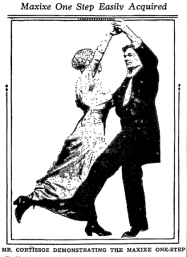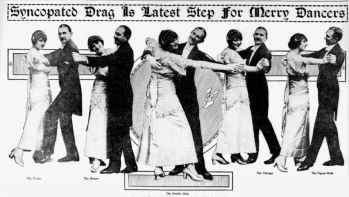Philadelphia Dance Teachers: Taking Steps
September 30, 2012

Ever since the 15th century, when the first dance manuals appeared to teach Italian nobles how to dance “correctly” at court, dance masters have been telling their students what and how to dance: “do point your toes,” “don’t shake your shoulders,” “do pay attention to the music,” “don’t show off,” and on and on and on. . .
ASSOCIATIONS GALORE
 By the end of the 19th century dancing in America was, in the eyes of some, in a sorry state. The intricate, European dances of mid-century–the polka, the mazurka and the waltz–were being slowly edged out by the simple twostep, a dance some referred to as the “idiot waltz,” see sheet music cover, left. No one needed hours of study in a class led by a professional to romp the twostep. In 1879, alarmed at what they were seeing, dance teachers from across the country formed the American Society of Professors of Dancing. Four years later, in 1883, the National Association of Masters of Dancing was formed in Boston. In 1894 the International Masters of Dancing held their first convention in St. Louis and by 1905 there was a United Professional Teachers of Dancing.
By the end of the 19th century dancing in America was, in the eyes of some, in a sorry state. The intricate, European dances of mid-century–the polka, the mazurka and the waltz–were being slowly edged out by the simple twostep, a dance some referred to as the “idiot waltz,” see sheet music cover, left. No one needed hours of study in a class led by a professional to romp the twostep. In 1879, alarmed at what they were seeing, dance teachers from across the country formed the American Society of Professors of Dancing. Four years later, in 1883, the National Association of Masters of Dancing was formed in Boston. In 1894 the International Masters of Dancing held their first convention in St. Louis and by 1905 there was a United Professional Teachers of Dancing.
 Initially, the goals of these associations were admirable. They aimed to standardize the steps that were taught across the country so that a dancer would be able to dance a waltz whether in Baltimore, Cincinnati or Boise. This tinkering with old steps inevitably led to trying their hand at choreographing “acceptable” new dances to introduce to the public. The associations also wanted to clean up the vulgar sloppiness and slouching that had crept into ballroom dancing, right. In 1893, they deigned to view the performance of Little Egypt and her danse du ventre (bellydance) at the Chicago World’s Fair. They wrote:
Initially, the goals of these associations were admirable. They aimed to standardize the steps that were taught across the country so that a dancer would be able to dance a waltz whether in Baltimore, Cincinnati or Boise. This tinkering with old steps inevitably led to trying their hand at choreographing “acceptable” new dances to introduce to the public. The associations also wanted to clean up the vulgar sloppiness and slouching that had crept into ballroom dancing, right. In 1893, they deigned to view the performance of Little Egypt and her danse du ventre (bellydance) at the Chicago World’s Fair. They wrote:
“The style of movements practiced by those so called Algerian and other women is something too objectionable for people of refined taste to countenance. It is a depraved and immoral exhibition. It may well be styled an outrage to allow such an exhibition and rate it under the head of dance.”
After 1900, with the appearance of the turkey trot, the grizzly bear, the shimmy and finally the charleston, dance teachers found their work cut out for them. With the bewildered public not sure of what kind of dancing was acceptable and what was not, dancing masters found themselves in a crucial new role. If they couldn’t continue selling the profitable lessons necessary to learn the old fashioned complex ballroom dances any more, teachers discovered that what they could sell was good taste. Each season they would decree what dances were no longer fashionable, which new dances were totally unacceptable always promoting a few new dances that they themselves had devised. Newspaper articles from those years tell the story:
“Professors of Dancing Bring the Waltz to Near Perfection”
“Dance Masters Decree Hugging Must Go”
“Dancing Experts Try to Reform Their Art”
“Dance Masters Fight Jazz”
PHILADELPHIA ENTERS THE FRAY
 Smaller organizations and chapters sprang up to combat problems on a local level. In 1893, the Philadelphia Association of Teachers of Dancing announced that they had enrolled nearly all the prominent dance teachers in the city. At their meetings during the summer, often held at the Jersey shore, they would announce what dances would be fit to grace Philadelphia ballrooms that fall season. In 1894, for instance, they introduced “The A l’Avenir,” “The Waltz Lancers,” and the “Chautaqua Square.” In 1914, they took it upon themselves to take on the newest dance, the foxtrot, and agreed to standardize five easy to learn figures. They dealt as decisively with the other ragtime dances that flooded ballrooms in the teens. They wrestled with the hesitation, the maxixe, and the onestep, and reduced them all to scientific formulas. Philadelphia dance master S. Wallace Cortissoz demonstrates the “onestep maxixe” for the Inquirer, above, left. The Philadelphia Association was soon seen as a model organization for the rest of the country. As the 1915 photo, below, shows, it indeed comprised all the most eminent dance teachers in the city. Mr. Cortissoz is second from the left in the top row of the photo.
Smaller organizations and chapters sprang up to combat problems on a local level. In 1893, the Philadelphia Association of Teachers of Dancing announced that they had enrolled nearly all the prominent dance teachers in the city. At their meetings during the summer, often held at the Jersey shore, they would announce what dances would be fit to grace Philadelphia ballrooms that fall season. In 1894, for instance, they introduced “The A l’Avenir,” “The Waltz Lancers,” and the “Chautaqua Square.” In 1914, they took it upon themselves to take on the newest dance, the foxtrot, and agreed to standardize five easy to learn figures. They dealt as decisively with the other ragtime dances that flooded ballrooms in the teens. They wrestled with the hesitation, the maxixe, and the onestep, and reduced them all to scientific formulas. Philadelphia dance master S. Wallace Cortissoz demonstrates the “onestep maxixe” for the Inquirer, above, left. The Philadelphia Association was soon seen as a model organization for the rest of the country. As the 1915 photo, below, shows, it indeed comprised all the most eminent dance teachers in the city. Mr. Cortissoz is second from the left in the top row of the photo.
 It’s difficult to assess whether either the Philadelphia or the national associations realized many of their goals. They were making a valiant effort to take control of their field, all the while promoting themselves and their services.
It’s difficult to assess whether either the Philadelphia or the national associations realized many of their goals. They were making a valiant effort to take control of their field, all the while promoting themselves and their services.
Did they “clean up” the dances? Nagging couples about dancing too closely, or about hopping too much seemed all too much like simply taking the fun out of dancing. Teachers could demand strict posture and decorum in their classes, but monitoring what actually went on out in public was another story. Usually, the things they objected to were exactly what made new dances they tried to ban so appealing.
Did they standardize dances? When the tango was introduced about 1913, a dance master complained that he had read over 120 variations of tango steps! Certainly, reducing dances to a manageable number of steps and figures made them easier to teach; standardization had its good points. However, just the fact that there were multiple national dance associations shows that in a large country like the U.S.A., there would always be regional tastes, styles and differences. Standardization of dances was much more successful in a small country like England, where dance masters from all over that nation taught identical curricula. Their success at standardization is one of the main reasons that the English became the main force in international competetive ballroom dance by the 1930s. It explains why competitors on Dancing with the Stars, a show created by the BBC, do British jive and not American swing dance.
Did dance masters introduce new dances to the ballroom that caught on with the public? Hardly. It seems that dance associations were even less successful in selling their choreographies to the public than they were in banning dances they didn’t care for. At each convention, dance teachers would submit their own choreographies and the best new dance would be chosen by vote. In 1915, the Philadelphia Dancing Masters created the “Philadelphia Six Step,” above, right, for which I would love to find music and directions. In 1920, they tried to replace the popular Shimmy with a dance they invented called the Radnor. In 1921, in a misguided attempt to appease anti-dance Methodists, the Dancing Masters named one of their new dances for the season “The Wesleyan.” The Methodist Conference was so insulted, they issued a statement calling the action of the Dancing Masters “an outrage against decency and an offense to every Methodist.” The Dancing Masters Association withdrew the dance. At best, the dances the associations created had limited popularity among their own students. The fact that we have never heard of the “Philadelphia Six Step,” or of the “Waltz Lancers,” “Radnor,” “Chautaqua Square,” or almost any other dance association creation for that matter, says a lot.
The tension between systemization and spontaneity, between doing what is correct and doing what is fun has, I think, led to the extreme dichotomy of social dancing today, where we have highly technical and stylized competitive ballroom dancing on one hand, and the uninhibited and unstructured but socially engaging dancing done at weddings, parties and bars in the real world on the other. On Dancing With the Stars, when the couple voted off go out on the floor and do a final, unrehearsed farewell dance, do they break into a foxtrot, a samba or a jive? No, they just rock back and forth, exactly like you or I do.


